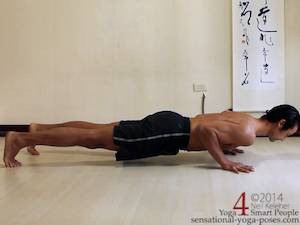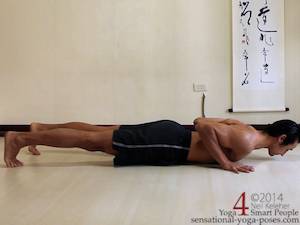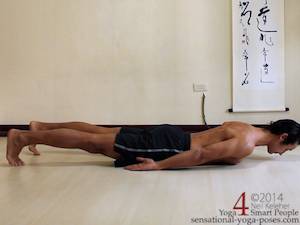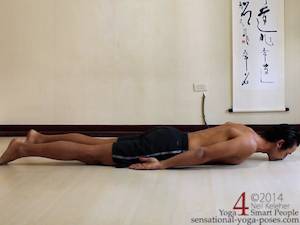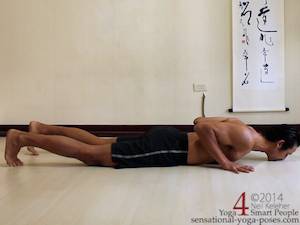From the Ground Up
Lifting up is easier than dropping down from plank because if your plank isn't that good then chaturanga isn't going to be that much better. So why not avoid plank for now and work into chaturanga dandasana in stages. From the Ground Up.
Quick Fix
Here's a summary.
Laying down, position your hands slightly ahead of your elbows.
- Push your hands forwards into the floor and then down.
- Lift your ribs.
Relax and repeat.
Rest when you need to.
As you lift up, the feeling is like you are pushing your hands and forerarms forwards into the floor. It's similar to the pushing back feeling in downward dog. To resist, you can push forwards with the fronts of your feet.
As you get used to this technique, you can then begin to adjust arm tension so that your shoulders feel comfortable. You can also play with elbow joint tension. Try "squeezing" the front and back of the elbow.
The following description is slightly more detailed.
Tensional Integrity
Apart from positioning the hands differently, one way to make the "push up position" yoga pose easier is to make your legs and spine long.
(The idea of doing this is to add tension to the connective tissue network of your body. For more on this idea read tensegrity.)
Making your spine and legs long creates space and the process of creating this space adds tension. That tension can make it easier to hold your body straight when you are horizontally lifting it off of the floor (or lowering it.)
Make Spine and Legs Feel Long
To make your spine long while laying on the floor, lift your head and pull your crown forwards, away from your ribcage.
Sitting up, the same action would be described as pulling your head back and up while keeping your chin level.
- As you pull your head up and forwards (while laying down) look down but feel your crown pushing forwards. You may find that your chest expands and reaches forwards also.
- To add tension to your intercostal spaces (the spaces between your ribs) as well as your waist, focus on reaching your ribs (and head) forwards, away from your pelvis.
- At the same time to make your legs long, push back through your heels, away from your pelvis, and straighten your knees. (Second picture above).
This is the feeling you'll try and keep in your spine and legs (and neck) as you lift up into chaturanga dandasana yoga pose.
Pushing Your Hands Forwards
Now it's time to look at the arms.
Because your forearms are angled forwards in this variation of the pose, you can push your hands forwards into the floor to help pull your elbows and shoulders back.
What do I mean?
First while laying down on your belly with your arms by your sides, lift your shoulders. Just your shoulders not your head or chest.
(Second picture below.)
Notice the feeling in your shoulders as you do this.
Now bend your elbows and place your hands ahead of your elbows (you may have to experiment with how far forwards or back.) Push your hands forwards against the floor.
Because of friction they won't actually move (and that is the intention.)
Instead the push will cause your elbows to point back. If you let it, it will also cause your shoulders to lift in the way that you just experienced.
- In the first picture below, my arms are relaxed.
- In the second picture my hands are pressed forwards to cause my shoulders to lift.
Practice this a few times, press your hands forwards to lift your shoulders, then relax your arms and let your shoulders move back down.
Wrist Protection: Press Down with your Finger Tips
Even though your wrist isn't as vulberable with your hands in this position, you should still protect them and the way to do that (possibly) is to add tension to your wrists. Do this by pressing your finger tips into the floor.
Spread your fingers, spread the bones in the palm of your hands and press your fingers into the floor.
At the same time friction your hands forwards to roll your shoulders back.
Now it's time to add everything together.
Lifting Up
Start with your spine and legs. Make them feel long. Pull your head forwards and up slightly.
Then press your finger tips into the floor and friction your hands forwards so that your shoulders lift. Then press your hands down keeping the forward pressure. Press your hands down to lift up into chaturanga.
If at first you don't succeed....
Step-by-Step
Rather than pushing down quickly, slowly press your hands down into the floor while at the same time keeping your body long and your hands pressing forwards.
- See if you can feel the point where your body starts to lift.
- Then slowly relax.
- Repeat, each time trying to add more downward pressure to your arms.
If that fails, then try lifting just your chest off of the floor but leave your pelvis down.
When you can lift your chest, then try lifting your chest and then your pelvis. Then finally lift chest, pelvis and then knees. And slowly lower.
This is only the beginning.
Once you can get up in chaturanga you can work at fine tuning your lift-up. I'd suggest using more forward pressure on your hands, as opposed to downward pressure, to lift up. Also, feel your arms and shoulders as you lift up. Try to make the "tension" or "strength" even throughout your shoulder and upper arm.
If there is pain, then try adjusting your arm position slightly.
Why do I suggest lifting the shoulders first?
That helps to keep the front of your shoulders open.
- Try to keep the fronts of your shoulders open as you lift up into chaturanga dandasana.
- In addition try to make the back of your shoulders (and upper back) feel open as well.
- And make sure that you keep your neck long.
If you can get up into chaturanga, then try pressing all the way up into plank pose while keeping your spine and legs long. And then try lowering yourself back down again.
And if you find yourself having shoulder problems, go back to the basics and work from the ground up to fix your problem.
So Why Is this Version Easier?
I like finding the easier way to do things, especially yoga poses. Why is this version of chaturanga easier than if you have your forearms vertical? Compare downward facing dog and plank pose. Which would you rather hold longer? Down dog is easier because you can fall into the pose. You use your hands to push your pelvis back and up. In plank you are using your arms to hold your body up.
If you angle your hands forwards in chaturanga, you can do the same thing, use your arms to help push your body back as opposed to up. (Key to this is that you do actually push your hands forwards.) If you aren't convinced, try out both versions and see for yourself.
So what about the shoulders and shoulder blades. What should they be doing in this pose? My feeling is that you should be using the serratus anterior muscle to support the body.
Published: 2012 02 10
Updated: 2021 02 09
